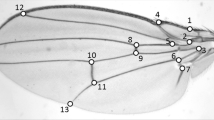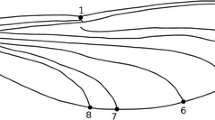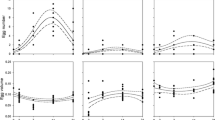Abstract
Wing shape has been shown in a variety of species to be influenced by natural and sexual selection. In damselflies, front- and hind wings can beat independently, and functional differentiation may occur. Males of Calopteryx damselflies show species-specific nuptial flights that differ in colour signalling with the hind wings. Therefore, hind wing shape and colour may evolve in concert to improve colour display, independent of the front wings. We predicted that male hind wing shape evolves faster than front wing shape, due to sexual selection. Females do not engage in sexual displays, so we predicted that females do not show differences in divergence between front- and hind wing shape. We analysed the non-allometric component of wing shape of five European Calopteryx taxa using geometric morphometrics. We found a higher evolutionary divergence of hind wing shape in both sexes. Indeed, we found no significant differences in rate of evolution between the sexes, despite clear sex-specific differences in wing shape. We suggest that evolution of hind wing shape in males is accelerated by sexual selection on pre-copulatory displays and that this acceleration is reflected in females due to genetic correlations that somehow link the rates of wing shape evolution in the two sexes, but not the wing shapes themselves.



Similar content being viewed by others
References
Adams, D. C., Rohlf, F. J., & Slice, D. E. (2004). Geometric morphometrics: Ten years of progress following the revolution. The Italian Journal of Zoology, 71, 5–16.
Anders, U., & Rüppell, G. (1997). Relationships of some European Calopteryx species suggested by time analysis of courtship flights. Entomologica Germanica, 21, 253–264.
Anderson, C. N., & Grether, G. F. (2010). Interspecific aggression and character displacement of competitor recognition in Hetaerina damselflies. Proceedings of the Royal Society Series B, 277, 549–555.
Arnqvist, G. (1998). Comparative evidence for the evolution of genitalia by sexual selection. Nature, 393, 784–786.
Askew, R. R. (2004). The dragonflies of Europe revised edition. Colchester: Harley Books.
Beldade, P., Koops, K., & Brakefield, P. M. (2002). Developmental constraints versus flexibility in morphological evolution. Nature, 416, 844–847.
Berwaerts, K., Aerts, P., & Van Dyck, H. (2006). On the sex-specific mechanisms of butterfly flight: Flight performance relative to flight morphology, wing kinematics, and sex in Pararge aegeria. Biological Journal of the Linnean Society, 89, 675–687.
Berwaerts, K., Van Dyck, H., & Aerts, P. (2002). Does flight morphology relate to flight performance? An experimental test with the butterfly Pararge aegeria. Functional Ecology, 16, 484–491.
Betts, C. R., & Wootton, R. J. (1988). Wing shape and flight behaviour in butterflies (Lepidoptera: Papilionoidea and Hesperioidea): A preliminary analysis. Journal of Experimental Biology, 138, 271–288.
Beukema, J. J. (2004). Recognition of conspecific females by males of Calopteryx haemorrhoidalis (Vander Linden) (Zygoptera: Calopterygidae). Odonatologica, 33, 147–156.
Bonduriansky, R., & Rowe, L. (2005). Intralocus sexual conflict and the genetic architecture of sexually dimorphic traits in Prochyliza xanthostoma (Diptera: Piophilidae). Evolution, 59, 1965–1975.
Bots, J., Breuker, C. J., Van Kerkhove, A., Van Dongen, S., De Bruyn, L., & Van Gossum, H. (2009). Variation in flight morphology in a female polymorphic damselfly: Intraspecific, intrasexual, and seasonal differences. Canadian Journal of Zoology, 87, 86–94.
Bowlin, M. S., & Wikelski, M. (2008). Pointed wings, low wingloading and calm air reduce migratory flight costs in songbirds. PLoS ONE, 3, e2154.
Breuker, C. J., Brakefield, P. M., & Gibbs, M. (2007). The association between wing morphology and dispersal is sex-specific in the glanville fritillary butterfly Melitaea cinxia (Lepidoptera: Nymphalidae). European Journal of Entomology, 104, 445–452.
Bullen, R. D., & McKenzie, N. L. (2007). Bat wing airfoil and planform structures relating to aerodynamic cleanliness. The Australian Journal of Zoology, 55, 237–247.
Calmaestra, R. G., & Moreno, E. (2001). A phylogenetically-based analysis on the relationship between wing morphology and migratory behaviour in Passeriformes. Ardea, 89, 407–416.
Chaput-Bardy, A., Grégorie, A., Baguette, M., Pagano, A., & Secondi, J. (2010). Condition and phenotype-dependent dispersal in a damselfly, Calopteryx splendens. PLoS ONE, 5, e10694.
Conrad, K. F., & Herman, T. B. (1987). Territorial and reproductive behaviour of Calopteryx aequabilis Say (Odonata: Calopterygidae) in Nova Scotia, Canada. Advances in Odonatology, 3, 41–50.
Contreras-Garduño, J., Buzatto, B. A., Serrano-Meneses, M. A., Nájera-Cordero, K., & Córdoba-Aguilar, A. (2008). The size of the red wing spot of the American rubyspot as a heightened condition-dependent ornament. Behavioral Ecology, 19, 724–732.
Córdoba-Aguilar, A. (2000). Reproductive behaviour of the territorial damselfly Calopteryx haemorrhoidalis asturica Ocharan (Zygoptera: Calopterygidae). Odonatologica, 29, 295–305.
Córdoba-Aguilar, A. (2002). Wing pigmentation in territorial male damselflies, Calopteryx haemorrhoidalis: a possible relation to sexual selection. Animal Behaviour, 63, 759–766.
Córdoba-Aguilar, A., & Cordero-Rivera, A. (2005). Evolution and ecology of Calopterygidae (Zygoptera: Odonata): Status of knowledge and research perspectives. Neotropical Entomology, 34, 861–879.
Córdoba-Aguilar, A., Salamanca-Ocaña, J. C., & Lopezaraiza, M. (2003). Female reproductive decisions and parasite burden in a calopterygid damselfly (Insecta: Odonata). Animal Behaviour, 66, 81–87.
Debat, V., Bégin, M., Legout, H., & David, J. R. (2003). Allometric and nonallometric components of Drosophila wing shape respond differently to developmental temperature. Evolution, 57, 2773–2784.
DeVries, P. J., Penz, C. M., & Hill, R. I. (2010). Vertical distribution, flight behaviour and evolution of wing morphology in Morpho butterflies. Journal of Animal Ecology, 79, 1077–1085.
Dockx, C. (2007). Directional and stabilizing selection on wing size and shape in migrant and resident monarch butterflies, Danaus plexippus (L.), in Cuba. Biological Journal of the Linnean Society, 92, 605–616.
Drummond, A. J., & Rambaut, A. (2007). BEAST: Bayesian evolutionary analysis by sampling trees. BMC Evolutionary Biology, 7, 214.
Dumont, H. J., Vanfleteren, J. R., De Jonckheere, J. F., & Weekers, P. H. H. (2005). Phylogenetic relationships, divergence time estimation, and global biogeographic patterns of Calopterygoid damselflies (Odonata, Zygoptera) inferred from ribosomal DNA sequences. Systematic Biology, 54, 347–362.
Endler, J. A. (1992). Signals, signal conditions, and the direction of evolution. American Naturalist, 139, S125–S153.
Eroukhmanoff, F., Outomuro, D., Ocharan, F. J., & Svensson, E. I. (2009). Patterns of phenotypic divergence in wing covariance structure of calopterygid damselflies. Evolutionary Biology, 36, 214–224.
Fernández, G., & Lank, D. B. (2007). Variation in the wing morphology of western sandpipers (Calidris mauri) in relation to sex, age class, and annual cycle. Auk, 124, 1037–1046.
Förschler, M. I., & Bairlein, F. (2011). Morphological shifts of the external flight apparatus across the range of a passerine (Northern wheatear) with diverging migratory behaviour. PLoS ONE, 6, e18732.
Gibbons, D. W., & Pain, D. (1992). The influence of river flow rate on the breeding behaviour of Calopteryx damselflies. Journal of Animal Ecology, 61, 283–289.
Grabow, K., & Rüppell, G. (1995). Wing loading in relation to size and flight characteristics of European Odonata. Odonatologica, 24, 175–186.
Grether, G. F. (1996). Intrasexual competition alone favors a sexually dimorphic ornament in the rubyspot damselfly Hetaerina americana. Evolution, 50, 1949–1957.
Grether, G. F., & Grey, R. M. (1996). Novel cost of a sexually selected trait in the rubyspot damselfly Hetaerina americana: conspicuousness to prey. Behavioral Ecology, 7, 465–473.
Hedenström, A. (2002). Aerodynamics, evolution and ecology of avian flight. Trends in Ecology & Evolution, 17, 415–422.
Hedenström, A., & Møller, A. P. (1992). Morphological adaptations to song flight in passerine birds: a comparative study. Proceedings of the Royal Society of London Series B, 247, 183–187.
Heymer, A. (1972). Comportements social et territorial des Calopterygidae (Odon. Zygoptera). Annales de la Société Entomologique de France, 8, 3–53.
Heymer, A. (1973). Étude du comportement reproducteur et analyse des mécanismes déclencheurs innés (MDI) optiques chez les Calopterygidae (Odon Zygoptera). Annales de la Société Entomologique de France, 9, 219–255.
Hill, J. K., Thomas, C. D., & Blakeley, D. S. (1999). Evolution of flight morphology in a butterfly that has recently expanded its geographic range. Oecologia, 121, 165–170.
Johansson, F., Söderquist, M., & Bokma, F. (2009). Insect wing shape evolution: independent effects of migratory and mate guarding flight on dragonfly wings. Biological Journal of the Linnean Society, 97, 362–372.
Kiauta, B. (1969). Sex chromosomes and sex determining mechanisms in Odonata, with a review of the cytological conditions in the family Gomphidae, and references to the karyotypic evolution in the order. Genetica, 40, 127–157.
Lele, S., & Richtsmeier, J. T. (1991). Euclidean distance matrix: a coordinate-free approach for comparing biological shapes using landmark data. American Journal of Physical Anthropology, 86, 415–427.
Maddison W, Maddison D. (2010). Mesquite Version 2.74. Available at: http://mesquiteproject.org/mesquite/mesquite.html.
Marchetti, K., Price, T., & Richman, A. (1995). Correlates of wing morphology with foraging behaviour and migration distance in the genus Phylloscopus. Journal of Avian Biology, 26, 177–181.
Meek, S. B., & Herman, T. B. (1990). A comparison of the reproductive behaviours of three Calopteryx species (Odonata: Calopterygidae) in Nova Scotia. Canadian Journal of Zoology, 68, 10–16.
Misof, B., Anderson, C. L., & Hadrys, H. (2000). A phylogeny of the damselfly Genus Calopteryx (Odonata) using mitochondrial 16S rDNA markers. Molecular Phylogenetics and Evolution, 15, 5–14.
Miyakawa, K. (1982). Reproductive behaviour and life span of adult Calopteryx atrata Selys and C virgo japonica Selys (Odonata: Zygoptera). Advances in Odonatology, 1, 193–203.
Monteiro, A., Brakefield, P. M., & French, V. (1997). The relationship between eyespot shape and wing shape in the butterfly Bicyclus anynana: A genetic and morphometrical approach. Journal of Evolutionary Biology, 10, 787–802.
Nijhout, H. F., Wray, G. A., & Gilbert, L. E. (1990). An analysis of the phenotypic effects of certain colour pattern genes in Heliconius (Lepidoptera: Nymphalidae). Biological Journal of the Linnean Society, 40, 357–372.
Norberg, U. M. (1995). How a long tail and changes in mass and wing shape affect the cost for flight in animals. Functional Ecology, 9, 48–54.
Norberg, U. M., & Rayner, J. M. V. (1987). Ecological morphology and flight in bats (Mammalia; Chiroptera): wing adaptations, flight performance, foraging strategy and echolocation. Philosophical transactions of the Royal Society of London Series B, 316, 335–427.
Oliver, J. C., Robertson, K. A., & Monteiro, A. (2009). Accommodating natural and sexual selection in butterfly wing pattern evolution. Proceedings of the Royal Society Series B, 276, 2369–2375.
Outomuro, D., & Johansson, F. (2011). The effects of latitude, body size and sexual selection on wing shape in a damselfly. Biological Journal of the Linnean Society, 102, 263–274.
Pajunen, V. I. (1966). Aggressive behaviour and territoriality in a population of Calopteryx virgo L. (Odon., Calopterygidae). Annales Zoologici Fennici, 3, 201–214.
Poissant, J., Wilson, A. J., & Coltman, D. W. (2009). Sex-specific genetic variance and the evolution of sexual dimorphism: a systematic review of cross-sex genetic correlations. Evolution, 64, 97–107.
Potti, J., & Canal, D. (2011). Heritability and genetic correlation between the sexes in a songbird sexual ornament. Heredity, 106, 945–954.
Rantala, M. J., Koskimäki, J., Taskinen, J., Tynkkynen, K., & Suhonen, J. (2000). Immunocompetence, developmental stability and wingspot size in the damselfly Calopteryx splendens L. Proceedings of the Royal Society of London Series B, 267, 2453–2457.
Reels, G. (2008). The phoenix damselfly (Pseudolestes mirabilis) of Hainan Island, China. Agrion, 12, 44–45.
Robert, P.-A. (1958). Les libellules (Odonates). Neuchâtel: Delachaux et Niestlé.
Rohlf F. J. (2004). TpsSplin, Version 1.20. Available at: http://life.bio.sunysb.edu/morph/.
Rohlf F. J. (2007). TpsTree, Version 1.21. Available at: http://life.bio.sunysb.edu/morph/.
Rohlf F. J. (2008). TpsRelw, Version 1.46. Available at: http://life.bio.sunysb.edu/morph/.
Rohlf F. J. (2009). TpsDig2, Version 2.14. Available at: http://life.bio.sunysb.edu/morph/.
Rohlf, F. J., & Slice, D. (1990). Extensions of the Procrustes method for the optimal superimposition of landmarks. Systematic Zoology, 39, 40–59.
Rüppell, G. (1989). Kinematic analysis of symmetrical flight manoeuvres of Odonata. Journal of Experimental Biology, 144, 13–42.
Rüppell, G., Hilfert-Rüppell, D., Rehfeldt, G., & Schütte, C. (2005). Die Prachtlibellen Europas. Gattung Calopteryx. Hohenwarsleben: Westarp Wissenschaften.
Rutowski, R. L., Nahm, A. C., & Macedonia, J. M. (2010). Iridescent hindwing patches in the Pipevine Swallowtail: differences in dorsal and ventral surfaces relate to signal function and context. Functional Ecology, 24, 767–775.
Santolamazza, S., Baquero, E., & Cordero-Rivera, A. (2011). Incidence of Anagrus obscurus (Hymenoptera: Mymaridae) egg parasitism on Calopteryx haemorrhoidalis and Platycnemis pennipes (Odonata: Calopterygidae: Platycnemididae) in Italy. Entomological Science, 14, 366–369.
Shingleton, A. W., Frankino, W. A., Flatt, T., Nijhout, H. F., & Emlen, D. J. (2007). Size and shape: The developmental regulation of static allometry in insects. Bioessays, 29, 536–548.
Siva-Jothy, M. T. (1999). Male wing pigmentation may affect reproductive success via female choice in a calopterygid damselfly (Zygoptera). Behaviour, 136, 1365–1377.
Siva-Jothy, M. T. (2000). A mechanistic link between parasite resistance and expression of a sexually selected trait in a damselfly. Proceedings of the Royal Society of London Series B, 267, 2523–2527.
Siva-Jothy, M. T., Gibbons, D. W., & Pain, D. (1995). Female oviposition-site preference and egg hatching success in the damselfly Calopteryx splendens xanthostoma. Behavioral Ecology and Sociobiology, 37, 39–44.
Siva-Jothy, M. T., & Plaistow, S. J. (1999). A fitness cost of eugregarine parasitism in a damselfly. Ecological Entomology, 24, 465–470.
Srygley, R. B. (1994). Locomotor mimicry in butterflies? The associations of positions of centres of mass among groups of mimetic, unprofitable prey. Philosophical transactions of the Royal Society of London B, 343, 145–155.
Srygley, R. B. (1999). Locomotor mimicry in Heliconius butterflies: contrast analyses of flight morphology and kinematics. Philosophical transactions of the Royal Society of London B, 354, 203–214.
Stiles, F. G., Altshuler, D. L., & Dudley, R. (2005). Wing morphology and flight behaviour of some North American hummingbird species. Auk, 122, 872–886.
Svensson, E. I., Eroukhmanoff, F., & Friberg, M. (2006). Effects of natural and sexual selection on adaptive population divergence and premating isolation in a damselfly. Evolution, 60, 1242–1253.
Svensson, E. I., & Friberg, M. (2007). Selective predation on wing morphology in sympatric damselflies. American Naturalist, 170, 101–112.
Svensson, E. I., Karlsson, K., Friberg, M., & Eroukhmanoff, F. (2007). Gender differences in species recognition and the evolution of asymmetric sexual isolation. Current Biology, 17, 1943–1947.
Tamura, K., Dudley, J., Nei, M., & Kumar, S. (2007). MEGA4: Molecular evolutionary genetics analysis (MEGA) software version 4.0. Molecular Biology and Evolution, 24, 1596–1599.
Taylor, G. K. (2001). Mechanics and aerodynamics of insect flight control. Biological Review, 76, 449–471.
Thompson, J. D., Higgins, D. G., & Gibson, T. J. (1994). CLUSTAL W: Improving the sensitivity of progressive multiple sequence alignment through sequence weighting, position-specific gap penalties and weight matrix choice. Nucleic Acids Research, 22, 4673–4680.
Tynkkynen, K., Rantala, M. J., & Suhonen, J. (2004). Interspecific aggression and character displacement in the damselfly Calopteryx splendens. Journal of Evolutionary Biology, 17, 759–767.
Voelker, G. (2001). Morphological correlates of migratory distance and flight display in the avian genus Anthus. Biological Journal of the Linnean Society, 73, 425–435.
Vukusic, P., Wooton, R. J., & Sambles, J. R. (2004). Remarkable iridescence in the hindwings of the damselfly Neurobasis chinensis chinensis (Linnaeus) (Zygoptera: Calopterygidae). Proceedings of the Royal Society of London B, 271, 595–601.
Waage, J. K. (1973). Reproductive behavior and its relation to territoriality in Calopteryx maculata (Beauvois) (Odonata: Calopterygidae). Behaviour, 47, 240–256.
Waage, J. K. (1975). Reproductive isolation and the potential for character displacement in the damselflies, Calopteryx maculata and C. aequabilis (Odonata: Calopterygidae). Systematic Zoology, 24, 24–36.
Waage, J. K. (1988). Reproductive behaviour of the damselfly Calopteryx dimidiata Burmeister (Zygoptera: Calopterygidae). Odonatologica, 17, 365–378.
Weekers, P. H. H., De Jonckheere, J. F., & Dumont, H. J. (2001). Phylogenetic relationships inferred from ribosomal ITS sequences and biogeographic patterns in representatives of the genus Calopteryx (Insecta: Odonata) of the West Mediterranean and adjacent West European zone. Molecular Phylogenetics and Evolution, 20, 89–99.
Wellenreuther, M., Tynkkynen, K., & Svensson, E. I. (2010). Simulating range expansion: male species recognition and loss of premating isolation in damselflies. Evolution, 64, 242–252.
Wootton, R. J. (1992). Functional morphology of insect wings. Annual Review of Entomology, 37, 113–140.
Acknowledgments
We are very grateful to Katja Kuitunen, Shawn Kutcha and Erik Svensson, who provided us some of the specimens for the current study. We want also thank Göran Arnqvist for advice on analysis of geometric morphometrics. This work was supported by the Swedish Research Council to F.J.
Author information
Authors and Affiliations
Corresponding author
Electronic supplementary material
Below is the link to the electronic supplementary material.
Rights and permissions
About this article
Cite this article
Outomuro, D., Bokma, F. & Johansson, F. Hind Wing Shape Evolves Faster than Front Wing Shape in Calopteryx Damselflies. Evol Biol 39, 116–125 (2012). https://doi.org/10.1007/s11692-011-9145-4
Received:
Accepted:
Published:
Issue Date:
DOI: https://doi.org/10.1007/s11692-011-9145-4




